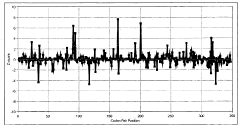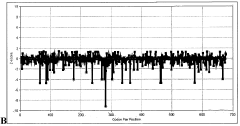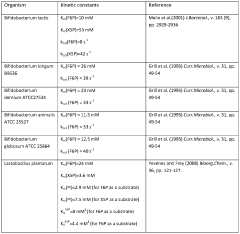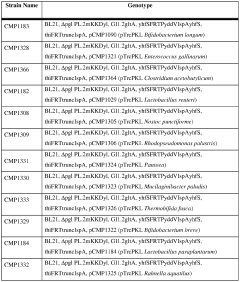Pentose Phosphate Pathway-Driven Synthesis of Precursors
Pentose Phosphate Pathway-Driven Synthesis of Precursors: Background and Objectives
The Pentose Phosphate Pathway (PPP) has emerged as a crucial metabolic pathway in cellular metabolism, playing a vital role in the synthesis of various precursors essential for life processes. This research focuses on harnessing the power of pentose phosphate pathway to drive the synthesis of key precursors, aiming to revolutionize biotechnological applications and enhance our understanding of cellular metabolism.
The PPP, also known as the hexose monophosphate shunt or the phosphogluconate pathway, is a metabolic pathway parallel to glycolysis. It serves two primary functions: generating reducing equivalents in the form of NADPH for reductive biosynthesis and producing ribose 5-phosphate for nucleotide synthesis. The pathway's ability to generate these crucial intermediates makes it an attractive target for biotechnological applications.
The evolution of PPP research has seen significant milestones over the past decades. Initially discovered in the 1930s, the pathway's importance in cellular metabolism became increasingly apparent as researchers unraveled its intricate mechanisms. Recent advancements in metabolic engineering and synthetic biology have opened new avenues for exploiting the PPP's potential in precursor synthesis.
This research aims to explore and optimize the PPP-driven synthesis of precursors, with several key objectives in mind. Firstly, we seek to enhance the efficiency of NADPH production through the oxidative branch of PPP, as this reducing equivalent is crucial for various biosynthetic processes. Secondly, we aim to manipulate the non-oxidative branch to increase the yield of sugar phosphates, particularly ribose 5-phosphate, which serves as a precursor for nucleotides and amino acids.
Another critical objective is to investigate the integration of PPP with other metabolic pathways to create novel synthetic routes for valuable precursors. This includes exploring the interplay between PPP and glycolysis, as well as its connections to amino acid biosynthesis pathways. By understanding and optimizing these interactions, we hope to develop more efficient and sustainable production methods for a wide range of biochemicals.
Furthermore, this research seeks to elucidate the regulatory mechanisms governing PPP flux and its distribution between the oxidative and non-oxidative branches. Understanding these control points will be crucial for developing strategies to redirect metabolic flux towards desired precursor synthesis. This knowledge will also contribute to our broader understanding of cellular metabolism and its adaptability to different environmental conditions.
Lastly, we aim to explore the potential of PPP-driven synthesis in various biotechnological applications, including the production of biofuels, pharmaceuticals, and fine chemicals. By leveraging the pathway's unique capabilities, we hope to establish new platforms for sustainable and efficient precursor synthesis, potentially revolutionizing industrial biotechnology processes.
Market Analysis for Pentose Phosphate Pathway-Derived Precursors
The market for precursors derived from the Pentose Phosphate Pathway (PPP) is experiencing significant growth, driven by increasing demand in various industries. The pharmaceutical sector represents a major market for these precursors, particularly in the production of nucleotides, nucleosides, and their analogs used in antiviral and anticancer drugs. The global nucleoside and nucleotide market is projected to expand at a compound annual growth rate (CAGR) of over 7% in the coming years.
The food and beverage industry is another key consumer of PPP-derived precursors, especially for the production of natural sweeteners and flavor enhancers. With the growing consumer preference for natural and low-calorie products, the demand for these precursors is expected to rise steadily. The natural sweeteners market, which includes products derived from PPP precursors, is forecasted to grow at a CAGR of around 6% over the next five years.
In the biotechnology sector, PPP-derived precursors are gaining traction in the development of biofuels and bio-based chemicals. The global bio-based chemicals market is anticipated to expand significantly, with some estimates suggesting a CAGR of over 10% in the near future. This growth is largely attributed to increasing environmental concerns and the shift towards sustainable production methods.
The cosmetics and personal care industry is also emerging as a promising market for PPP-derived precursors. These compounds are being utilized in the formulation of anti-aging products and skin-lightening agents. The global cosmeceuticals market, which includes such products, is expected to grow at a CAGR of approximately 8% in the coming years.
Geographically, North America and Europe currently dominate the market for PPP-derived precursors, owing to their advanced pharmaceutical and biotechnology industries. However, the Asia-Pacific region is anticipated to witness the fastest growth, driven by rapid industrialization, increasing healthcare expenditure, and growing awareness of bio-based products.
The market is characterized by intense competition among key players, including pharmaceutical companies, biotechnology firms, and chemical manufacturers. These companies are investing heavily in research and development to enhance the efficiency of PPP-driven synthesis and expand the application scope of the resulting precursors.
Despite the positive outlook, the market faces challenges such as high production costs and complex regulatory requirements, particularly in the pharmaceutical and food industries. However, ongoing technological advancements and increasing collaborations between academia and industry are expected to address these challenges and further drive market growth.
Current Challenges in Pentose Phosphate Pathway-Driven Synthesis
The Pentose Phosphate Pathway (PPP) has emerged as a promising route for the synthesis of valuable precursors in biotechnology and metabolic engineering. However, several challenges currently hinder the full exploitation of PPP-driven synthesis. One of the primary obstacles is the complex regulation of the pathway, which involves multiple enzymes and intermediates. This intricate control mechanism makes it difficult to manipulate the flux through the pathway for optimal precursor production.
Another significant challenge is the competition between the PPP and other central metabolic pathways, such as glycolysis and the tricarboxylic acid (TCA) cycle. The interconnectedness of these pathways often results in undesired carbon loss and reduced yields of target precursors. Balancing the flux distribution between these pathways remains a critical hurdle in maximizing PPP-driven synthesis efficiency.
The limited availability of NADPH, a crucial cofactor in many PPP-related reactions, poses another challenge. While the PPP is a major source of NADPH in cells, the demand for this cofactor in precursor synthesis often exceeds its natural production rate. This imbalance can lead to bottlenecks in the synthetic process and limit overall productivity.
Furthermore, the accumulation of toxic intermediates during PPP-driven synthesis can negatively impact cell growth and metabolism. This toxicity issue is particularly pronounced when attempting to produce non-native compounds or when pushing the pathway beyond its natural capacity. Developing strategies to mitigate these toxic effects without compromising precursor yields is an ongoing challenge.
The genetic instability of engineered strains optimized for PPP-driven synthesis presents another hurdle. Long-term cultivation often leads to the loss of desired genetic modifications or the accumulation of mutations that reduce pathway efficiency. Maintaining strain stability while achieving high productivity remains a significant challenge in industrial applications.
Additionally, scaling up PPP-driven synthesis processes from laboratory to industrial levels introduces new challenges. Factors such as oxygen transfer, substrate feeding, and product removal become increasingly critical at larger scales. Optimizing these parameters while maintaining the delicate balance of the PPP and associated pathways is essential for successful commercialization.
Lastly, the limited understanding of the PPP's interaction with cellular stress responses and global metabolic regulation hinders the development of robust and predictable production systems. Elucidating these complex relationships and developing strategies to harness them for improved precursor synthesis remains a key challenge in the field.
Existing Pentose Phosphate Pathway-Driven Synthesis Methodologies
01 Genetic engineering of microorganisms for enhanced pentose phosphate pathway
Genetic modification techniques are used to enhance the pentose phosphate pathway in microorganisms. This involves altering genes related to key enzymes in the pathway to increase the production of precursors and improve overall efficiency. These modifications can lead to increased yields of valuable compounds derived from the pentose phosphate pathway.- Genetic engineering of microorganisms for enhanced pentose phosphate pathway: Genetic modification techniques are used to enhance the pentose phosphate pathway in microorganisms. This involves altering genes related to key enzymes in the pathway, such as glucose-6-phosphate dehydrogenase or 6-phosphogluconate dehydrogenase. The goal is to increase the production of precursors like ribose-5-phosphate and NADPH, which are essential for various biosynthetic processes.
- Optimization of culture conditions for pentose phosphate pathway precursor synthesis: Researchers focus on optimizing culture conditions to enhance the production of precursors through the pentose phosphate pathway. This includes adjusting factors such as pH, temperature, oxygen levels, and nutrient composition. The aim is to create an environment that favors the activity of enzymes involved in the pathway, thereby increasing the yield of desired precursors.
- Integration of pentose phosphate pathway with other metabolic pathways: This approach involves integrating the pentose phosphate pathway with other metabolic pathways to improve the overall production of precursors. By coordinating the pentose phosphate pathway with glycolysis, the TCA cycle, or amino acid biosynthesis pathways, researchers aim to create a more efficient system for generating desired precursors and reducing byproduct formation.
- Development of novel enzymes for pentose phosphate pathway enhancement: Research is conducted to develop or discover novel enzymes that can enhance the efficiency of the pentose phosphate pathway. This may involve protein engineering, directed evolution, or screening of microbial libraries to identify enzymes with improved catalytic properties or stability. The goal is to overcome rate-limiting steps in the pathway and increase precursor production.
- Utilization of alternative carbon sources in pentose phosphate pathway: Researchers explore the use of alternative carbon sources to feed into the pentose phosphate pathway for precursor synthesis. This may include utilizing pentose sugars from lignocellulosic biomass or developing strategies to efficiently convert other carbon sources into pathway intermediates. The aim is to diversify feedstock options and improve the economic viability of precursor production.
02 Optimization of culture conditions for pentose phosphate pathway precursor synthesis
Researchers focus on optimizing culture conditions to enhance the synthesis of precursors through the pentose phosphate pathway. This includes adjusting factors such as temperature, pH, nutrient composition, and oxygen levels to create an ideal environment for microorganisms to produce desired precursors efficiently.Expand Specific Solutions03 Integration of pentose phosphate pathway with other metabolic pathways
Studies explore the integration of the pentose phosphate pathway with other metabolic pathways to improve the overall production of precursors. This approach involves engineering microorganisms to create synergies between different pathways, leading to more efficient use of resources and increased yields of desired compounds.Expand Specific Solutions04 Development of novel enzymes for pentose phosphate pathway enhancement
Research focuses on developing novel enzymes or modifying existing ones to enhance the pentose phosphate pathway. This includes protein engineering techniques to create more efficient or stable enzymes that can improve the overall performance of the pathway and increase precursor production.Expand Specific Solutions05 Utilization of alternative carbon sources in pentose phosphate pathway
Investigations are conducted on the use of alternative carbon sources to feed into the pentose phosphate pathway for precursor synthesis. This approach aims to diversify the range of raw materials that can be used, potentially reducing costs and improving sustainability in the production of valuable compounds derived from the pathway.Expand Specific Solutions
Key Players in Pentose Phosphate Pathway-Based Precursor Production
The research on Pentose Phosphate Pathway-Driven Synthesis of Precursors is in a developing stage, with growing market potential due to its applications in biotechnology and pharmaceutical industries. The market size is expanding as more companies recognize the importance of this pathway in metabolic engineering and bioproduction. Technologically, it's progressing from basic research to applied science, with varying levels of maturity among key players. Companies like BASF SE, DSM IP Assets BV, and DuPont de Nemours, Inc. are at the forefront, leveraging their expertise in biochemistry and industrial biotechnology. Academic institutions such as Yale University and The Regents of the University of California are contributing significant advancements in fundamental research, while companies like Ajinomoto Co., Inc. and Evonik Operations GmbH are focusing on practical applications in fermentation and bioproduction processes.
BASF SE
Ajinomoto Co., Inc.
Core Innovations in Pentose Phosphate Pathway Engineering
- Development of nucleotide sequences with refined translational kinetics by replacing codon pairs that cause translation pauses with alternative codons encoding identical amino acids or conservative substitutions, optimized for specific host organisms to enhance protein expression and activity.
- Engineered recombinant cells expressing phosphoketolase and mevalonate pathway enzymes to produce mevalonate, isoprene, and isoprenoids, utilizing substrates like xylulose 5-phosphate and fructose 6-phosphate to enhance carbon flux and yield through the mevalonate-dependent biosynthetic pathway.
Metabolic Engineering Strategies for Pentose Phosphate Pathway Enhancement
Metabolic engineering strategies for enhancing the pentose phosphate pathway (PPP) have gained significant attention in recent years due to their potential to improve the production of valuable precursors and bioproducts. These strategies aim to redirect carbon flux towards the PPP, increase the availability of key intermediates, and optimize the overall pathway efficiency.
One of the primary approaches involves overexpressing key enzymes in the PPP. This includes glucose-6-phosphate dehydrogenase (G6PDH), 6-phosphogluconate dehydrogenase (6PGDH), and transketolase (TKT). By increasing the expression of these enzymes, researchers can enhance the flux through the oxidative and non-oxidative branches of the PPP, leading to improved production of NADPH and pentose sugars.
Another strategy focuses on modulating the expression of competing pathways. This often involves downregulating or knocking out enzymes in glycolysis or other central carbon metabolism pathways to redirect carbon flux towards the PPP. For example, reducing the activity of phosphoglucose isomerase (PGI) can increase the availability of glucose-6-phosphate for the PPP.
Cofactor engineering is also a crucial aspect of PPP enhancement. Strategies such as increasing the NADP+/NADPH ratio or improving the regeneration of NADP+ can drive the oxidative branch of the PPP. This can be achieved through the introduction of NADPH-consuming reactions or by engineering NADH kinases to convert NADH to NADPH.
Recent advances in synthetic biology have enabled the development of novel PPP variants. These include the creation of synthetic pathways that bypass rate-limiting steps or introduce new connections between different metabolic modules. For instance, researchers have designed artificial pathways that directly convert xylose to xylulose-5-phosphate, bypassing several steps in the native PPP.
Adaptive laboratory evolution has emerged as a powerful tool for PPP enhancement. By subjecting microorganisms to specific selective pressures, researchers can evolve strains with improved PPP activity. This approach has been successful in generating strains with increased tolerance to oxidative stress and enhanced production of PPP-derived metabolites.
Integration of systems biology approaches has also contributed to PPP optimization. Genome-scale metabolic models and flux balance analysis have been used to identify potential targets for genetic manipulation and predict the effects of various interventions on PPP flux. These in silico tools enable more rational and efficient design of metabolic engineering strategies.
Sustainability Aspects of Pentose Phosphate Pathway-Driven Biosynthesis
The sustainability aspects of Pentose Phosphate Pathway (PPP)-driven biosynthesis are crucial considerations in the development and implementation of this technology. As industries increasingly prioritize environmentally friendly processes, PPP-driven biosynthesis offers several advantages in terms of sustainability.
One of the primary benefits of PPP-driven biosynthesis is its potential for reducing reliance on fossil fuel-derived precursors. By utilizing renewable biomass as a feedstock, this approach can significantly decrease the carbon footprint associated with the production of various chemicals and materials. The PPP pathway enables the efficient conversion of plant-based sugars into valuable precursors, thereby promoting a more circular and sustainable bioeconomy.
Furthermore, PPP-driven biosynthesis often operates under milder conditions compared to traditional chemical synthesis methods. This results in lower energy requirements and reduced greenhouse gas emissions. The use of enzymes and microorganisms in the process also minimizes the need for harsh chemicals and solvents, leading to a reduction in hazardous waste generation and environmental pollution.
The scalability of PPP-driven biosynthesis is another important sustainability aspect. As the technology advances, it becomes increasingly feasible to implement large-scale production processes that maintain high efficiency and low environmental impact. This scalability is crucial for meeting the growing demand for sustainable alternatives to petrochemical-based products.
Water conservation is an additional sustainability benefit of PPP-driven biosynthesis. Many biological processes require less water compared to traditional chemical manufacturing methods. Moreover, the water used in these processes can often be recycled or treated more easily, further reducing the overall water footprint of production.
The use of PPP-driven biosynthesis also contributes to biodiversity conservation. By utilizing renewable biomass feedstocks, this approach can potentially reduce the pressure on natural resources and ecosystems associated with the extraction and processing of fossil fuels. Additionally, the development of diverse bio-based products can lead to the cultivation of a wider range of crop species, promoting agricultural biodiversity.
Lastly, the sustainability of PPP-driven biosynthesis extends to its potential for creating a more resilient and localized production system. By enabling the production of valuable chemicals and materials from locally available biomass, this technology can reduce transportation costs and associated emissions while fostering regional economic development and resource independence.







